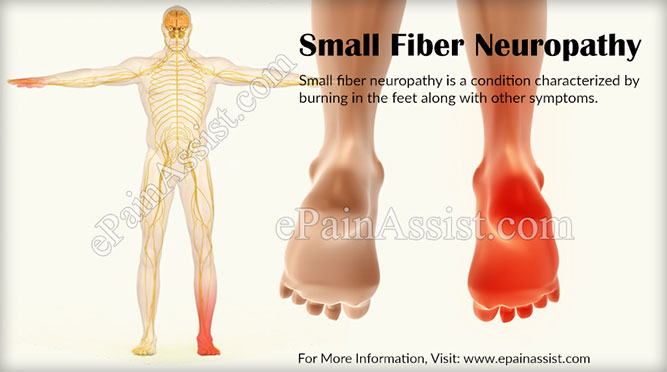Small fiber neuropathy is a condition characterized by burning in the feet along with other symptoms. There are various causes and conditions which can contribute to this condition. It is commonly seen in elderly people and those with conditions like diabetes too are at an increased risk of small fiber neuropathy. It is therefore, important to know the causes, symptoms, diagnosis and treatment of small fiber neuropathy.
Small fiber neuropathy is a condition in which the peripheral sensory or autonomic or both types of nerves are involved. Small fibers are particularly responsible for innervating the skin, smooth muscles like that of the heart and involuntary muscles. When the small fibers of the nerves get affected, it can result in sensory problems, disturb autonomic function and can also cause pain.
As nerve related conditions are many, it is important to understand the symptoms of each condition and properly diagnose small fiber neuropathy. Timely diagnosis and appropriate treatment is essential to ensure treating the condition and prevent further damage.

Causes of Small Fiber Neuropathy
In many cases, the exact cause of small fiber neuropathy is not known, however, in most cases, there are associated conditions. Some conditions like diabetes, peripheral neuropathy, thyroid dysfunction, vitamin B 12 deficiency, connective tissue disorders, immune disorders and other metabolic problems may increase the risk of small fiber neuropathy.
Some of the common causes of small fiber neuropathy include:
- Diabetes – It is believed that people having diabetes can have impaired nerve function and are at greater risk of having small fiber neuropathy. In most diabetic patients and in those where the glucose tolerance is affected, painful small fiber neuropathy can be noted. Some studies also suggest that pre-diabetics too are at an increased risk of small fiber neuropathy.
- Metabolic Syndrome – Metabolic syndrome, which characterizes with diabetes, hypertension, high cholesterol and obesity, is a dangerous combination and can be one of the causes of small fiber neuropathy.
- Genetics – Sometimes, small fiber neuropathy can be caused due to certain genetic conditions or disorders having hereditary tendencies.
- Others – Some of the other causes of small fiber neuropathy include auto-immune disorders and immunodeficiency virus. Some causes may also be related to drug toxicity.
Symptoms of Small Fiber Neuropathy
Small fiber neuropathy mainly affects the nerves and the symptoms depend on whether it affects the peripheral or the autonomic system or both.
Some of the common symptoms of small fiber neuropathy include
- Pain, burning or tingling in the limbs
- Sensation of pins and needles
- Electric shock like sudden pain along the nerve course
- Cramping pain in calves and feet
Initially the symptoms may be mild but gradually they begin to worsen, particularly if no treatment is received. For some people, the distribution of area for the symptoms of small fiber neuropathy may be clear but for many the area may spread to involve nearby parts as well. People usually have symptoms in feet, which may sometimes also begin affecting the hands in advanced cases. People experiencing symptoms in the arms and hands can eventually also experience tingling, numbness or pain in the face, trunk and neck region.
Some of the autonomic symptoms of small fiber neuropathy include those which affect the temperature control, sweating and blood pressure control.
Some autonomic symptoms of small fiber neuropathy include
- Dryness of mouth, dry eyes and dry mucus membranes
- Postural hypotension or dropping of blood pressure with postural changes
- Dizziness, particularly with change of position,
- Difficulty in temperature regulation, feeling too hot or too cold
- Sudden skin color changes from red to pale appearance.
Diagnosis of Small Fiber Neuropathy
Diagnosis of small fiber neuropathy can be made with complete history and physical examination. History can reveal previous causes of nerve damage, family and past history regarding illnesses, which can cause small fiber neuropathy. Laboratory investigations help to reveal the presence of diabetes, problems regarding blood glucose tolerance, thyroid function and other autoimmune disorders.
Investigations like electromyography and nerve conduction studies are done to determine the involvement of nerve disorders. In some cases, skin biopsies may be ordered to determine loss of nerve function around the skin area. In some rare cases, biopsies of the nerve and muscles may be required to aid diagnosis of small fiber neuropathy.
Treatment of Small Fiber Neuropathy
Treatment of small fiber neuropathy mainly aims at stopping the nerve damage and reversing the damage as much as possible. The main treatment approach is to treat the underlying cause of small fiber neuropathy, if any. For diabetics it is essential to maintain blood glucose levels with appropriate medication, follow a healthy diet and exercise regimen. Weight management plays an important role in reducing insulin resistance and appropriate measures must be taken to maintain an ideal weight.
Medicines that control pain, antidepressants and anti-seizure medications are often prescribed and must be taken according to medical advice. Adequate rest and proper exercises too can help to manage pain and other symptoms of small fiber neuropathy. Physical therapy and nerve stimulation may be recommended in some cases for treatment of small fiber neuropathy.
Meditation and relaxation techniques too can help to relax the mind and bring positive results. However, understanding the symptoms of small fiber neuropathy, making appropriate diagnosis and planning treatment of small fiber neuropathy is very important.
Also Read:
